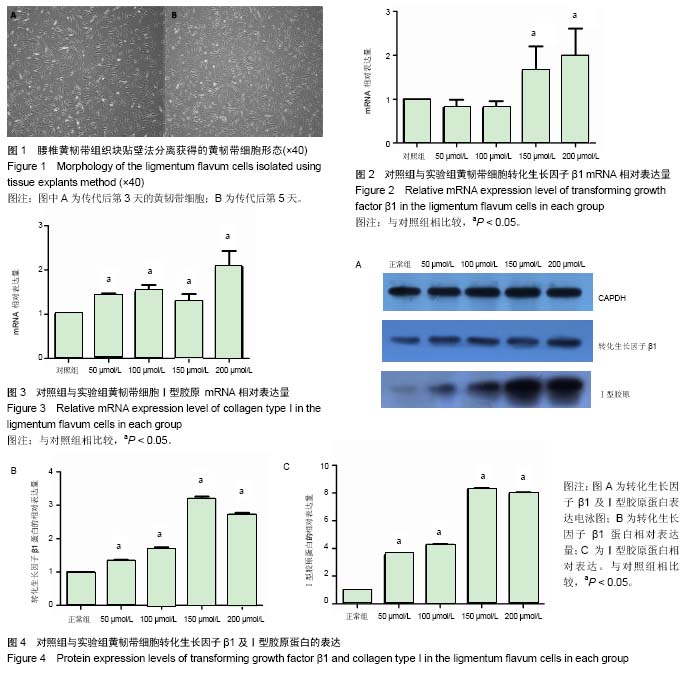中国组织工程研究 ›› 2017, Vol. 21 ›› Issue (12): 1867-1871.doi: 10.3969/j.issn.2095-4344.2017.12.011
• 肌肉肌腱韧带组织构建 tissue construction of the muscle, tendon and ligament • 上一篇 下一篇
腰椎黄韧带增生肥厚中氧自由基H2O2介导转化生长因子β1表达的作用及意义
王智清,陈雄生,周盛源,许国峰
- 解放军第二军医大学附属长征医院脊柱三科,上海市 200003
Role and significance of hydrogen peroxide-induced transforming growth factor beta1 expression in ligamentum flavum hypertrophy
Wang Zhi-qing, Chen Xiong-sheng, Zhou Sheng-yuan, Xu Guo-feng
- Third Department of Spinal Surgery, Changzheng Hospital Affiliated to the Second Military Medical University, Shanghai 200003, China
摘要:
文章快速阅读:
.jpg) 文题释义:
氧自由基:生物体系中的自由基主要是氧自由基,其成员有超氧化物自由基、过氧化氢、羟自由基、单线态氧、过氧化脂质,通称活性氧。体内活性氧自由基在免疫和信号传导过程中发挥功能。但活性氧自由基产生过度就会导致人体正常细胞和组织的损坏,从而加速衰老以及引起多种疾病,如组织器官退变、心脑血管疾病等。
黄韧带肥厚:黄韧带是连接于相邻两椎板间的结缔组织,其厚度在脊柱不同部位有所差异:颈段薄,胸段稍厚,腰段最厚。1938年,Naffziger等第一次提出黄韧带肥厚是韧带微小损伤后逐渐导致纤维化。随着黄韧带肥厚的进展,弹性纤维逐渐减少并消失,胶原纤维增加。同时,许多学者发现肥厚黄韧带中出现成纤维细胞、软骨细胞增殖和钙盐沉积,甚至骨化,并且在关节囊及韧带附着点处尤为显著。腰椎黄韧带肥厚是腰椎管狭窄发生的重要因素,可引起严重的神经压迫症状。在临床治疗上,以减压手术解除马尾及神经根压迫为主。
文题释义:
氧自由基:生物体系中的自由基主要是氧自由基,其成员有超氧化物自由基、过氧化氢、羟自由基、单线态氧、过氧化脂质,通称活性氧。体内活性氧自由基在免疫和信号传导过程中发挥功能。但活性氧自由基产生过度就会导致人体正常细胞和组织的损坏,从而加速衰老以及引起多种疾病,如组织器官退变、心脑血管疾病等。
黄韧带肥厚:黄韧带是连接于相邻两椎板间的结缔组织,其厚度在脊柱不同部位有所差异:颈段薄,胸段稍厚,腰段最厚。1938年,Naffziger等第一次提出黄韧带肥厚是韧带微小损伤后逐渐导致纤维化。随着黄韧带肥厚的进展,弹性纤维逐渐减少并消失,胶原纤维增加。同时,许多学者发现肥厚黄韧带中出现成纤维细胞、软骨细胞增殖和钙盐沉积,甚至骨化,并且在关节囊及韧带附着点处尤为显著。腰椎黄韧带肥厚是腰椎管狭窄发生的重要因素,可引起严重的神经压迫症状。在临床治疗上,以减压手术解除马尾及神经根压迫为主。
.jpg) 文题释义:
氧自由基:生物体系中的自由基主要是氧自由基,其成员有超氧化物自由基、过氧化氢、羟自由基、单线态氧、过氧化脂质,通称活性氧。体内活性氧自由基在免疫和信号传导过程中发挥功能。但活性氧自由基产生过度就会导致人体正常细胞和组织的损坏,从而加速衰老以及引起多种疾病,如组织器官退变、心脑血管疾病等。
黄韧带肥厚:黄韧带是连接于相邻两椎板间的结缔组织,其厚度在脊柱不同部位有所差异:颈段薄,胸段稍厚,腰段最厚。1938年,Naffziger等第一次提出黄韧带肥厚是韧带微小损伤后逐渐导致纤维化。随着黄韧带肥厚的进展,弹性纤维逐渐减少并消失,胶原纤维增加。同时,许多学者发现肥厚黄韧带中出现成纤维细胞、软骨细胞增殖和钙盐沉积,甚至骨化,并且在关节囊及韧带附着点处尤为显著。腰椎黄韧带肥厚是腰椎管狭窄发生的重要因素,可引起严重的神经压迫症状。在临床治疗上,以减压手术解除马尾及神经根压迫为主。
文题释义:
氧自由基:生物体系中的自由基主要是氧自由基,其成员有超氧化物自由基、过氧化氢、羟自由基、单线态氧、过氧化脂质,通称活性氧。体内活性氧自由基在免疫和信号传导过程中发挥功能。但活性氧自由基产生过度就会导致人体正常细胞和组织的损坏,从而加速衰老以及引起多种疾病,如组织器官退变、心脑血管疾病等。
黄韧带肥厚:黄韧带是连接于相邻两椎板间的结缔组织,其厚度在脊柱不同部位有所差异:颈段薄,胸段稍厚,腰段最厚。1938年,Naffziger等第一次提出黄韧带肥厚是韧带微小损伤后逐渐导致纤维化。随着黄韧带肥厚的进展,弹性纤维逐渐减少并消失,胶原纤维增加。同时,许多学者发现肥厚黄韧带中出现成纤维细胞、软骨细胞增殖和钙盐沉积,甚至骨化,并且在关节囊及韧带附着点处尤为显著。腰椎黄韧带肥厚是腰椎管狭窄发生的重要因素,可引起严重的神经压迫症状。在临床治疗上,以减压手术解除马尾及神经根压迫为主。摘要
背景:目前腰椎黄韧带肥厚的病理机制尚不明确,转化生长因子β1在肥厚黄韧带中表达明显增加。研究表明体内氧自由基堆积与组织器官退变密切相关,氧自由基可能通过介导转化生长因子β1表达参与腰椎黄韧带肥厚的进展。
目的:观察氧自由基H2O2介导的人黄韧带细胞中转化生长因子β1、Ⅰ型胶原表达增加在腰椎黄韧带肥厚过程中的影响及意义。
方法:腰椎后路减压术中取影像学上无黄韧带肥厚的单纯腰椎间盘突出症患者的腰椎黄韧带标本1例,进行体外细胞分离、培养,采用经培养的第4-6代细胞,应用H2O2对其进行干预,建立低氧诱导模型。设立正常对照组、H2O2浓度50 μmol/L组、100 μmol/L组、150 μmol/L组、200 μmol/L组,干预72 h,通过实时定量PCR(RT-qPCR)和Western blot方法分别检测转化生长因子β1、Ⅰ型胶原的mRNA及蛋白表达。
结果与结论:①RT-qPCR检测结果显示:H2O2浓度150 μmol/L组、200 μmol/L组转化生长因子β1 mRNA表达显著增加(P < 0.05);实验组Ⅰ型胶原mRNA表达均高于对照组(P < 0.05),且200 μmol/L组表达显著高于其余实验组,差异有显著性意义(P < 0.05);②Western blot检测结果显示:随H2O2浓度增加,转化生长因子β1、Ⅰ型胶原蛋白水平表达显著增加(P < 0.05);③结果表明,氧自由基H2O2通过刺激人腰椎黄韧带细胞产生转化生长因子β1,上调Ⅰ型胶原表达,进而促进腰椎黄韧带增生肥厚。
中国组织工程研究杂志出版内容重点:组织构建;骨细胞;软骨细胞;细胞培养;成纤维细胞;血管内皮细胞;骨质疏松;组织工程
ORCID: 0000-0003-1287-0057(王智清)
中图分类号:

.jpg) 文题释义:
氧自由基:生物体系中的自由基主要是氧自由基,其成员有超氧化物自由基、过氧化氢、羟自由基、单线态氧、过氧化脂质,通称活性氧。体内活性氧自由基在免疫和信号传导过程中发挥功能。但活性氧自由基产生过度就会导致人体正常细胞和组织的损坏,从而加速衰老以及引起多种疾病,如组织器官退变、心脑血管疾病等。
黄韧带肥厚:黄韧带是连接于相邻两椎板间的结缔组织,其厚度在脊柱不同部位有所差异:颈段薄,胸段稍厚,腰段最厚。1938年,Naffziger等第一次提出黄韧带肥厚是韧带微小损伤后逐渐导致纤维化。随着黄韧带肥厚的进展,弹性纤维逐渐减少并消失,胶原纤维增加。同时,许多学者发现肥厚黄韧带中出现成纤维细胞、软骨细胞增殖和钙盐沉积,甚至骨化,并且在关节囊及韧带附着点处尤为显著。腰椎黄韧带肥厚是腰椎管狭窄发生的重要因素,可引起严重的神经压迫症状。在临床治疗上,以减压手术解除马尾及神经根压迫为主。
文题释义:
氧自由基:生物体系中的自由基主要是氧自由基,其成员有超氧化物自由基、过氧化氢、羟自由基、单线态氧、过氧化脂质,通称活性氧。体内活性氧自由基在免疫和信号传导过程中发挥功能。但活性氧自由基产生过度就会导致人体正常细胞和组织的损坏,从而加速衰老以及引起多种疾病,如组织器官退变、心脑血管疾病等。
黄韧带肥厚:黄韧带是连接于相邻两椎板间的结缔组织,其厚度在脊柱不同部位有所差异:颈段薄,胸段稍厚,腰段最厚。1938年,Naffziger等第一次提出黄韧带肥厚是韧带微小损伤后逐渐导致纤维化。随着黄韧带肥厚的进展,弹性纤维逐渐减少并消失,胶原纤维增加。同时,许多学者发现肥厚黄韧带中出现成纤维细胞、软骨细胞增殖和钙盐沉积,甚至骨化,并且在关节囊及韧带附着点处尤为显著。腰椎黄韧带肥厚是腰椎管狭窄发生的重要因素,可引起严重的神经压迫症状。在临床治疗上,以减压手术解除马尾及神经根压迫为主。